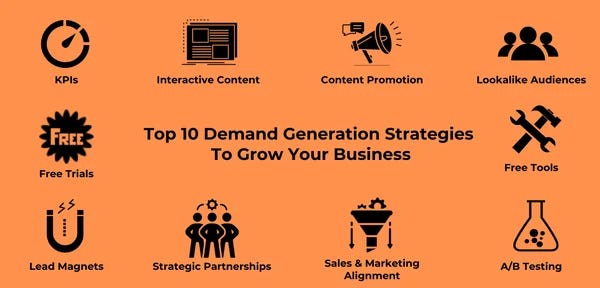From $1M to $10M: Proven Demand Generation Strategies for Rapid Growth

Are you ready to turn your startup into a revenue powerhouse? Don’t miss out on the strategies that could scale your business from $1M to $10M in record time!
Scaling a company from $1 million to $10 million is no small feat. It requires a well-crafted demand generation strategy that can adapt to changing market dynamics and leverage cutting-edge technologies. In this blog, we’ll explore proven demand generation strategies that have helped businesses achieve rapid growth and provide a practical plan with a timeline to guide your journey.
1. Embrace Inbound Marketing with a Twist
Content Marketing: Content is still king, but it needs a fresh approach. Create high-quality, SEO-optimized content that addresses your audience’s pain points. For example, HubSpot increased its organic traffic by 50% by regularly publishing in-depth blog posts and resources.
Lead Magnets: Offer valuable resources such as eBooks, whitepapers, and webinars in exchange for contact information. According to MarketingSherpa, 79% of B2B marketers believe that lead magnets are effective for generating leads.
2. Leverage Outbound Marketing with Precision
Account-Based Marketing (ABM): Target high-value accounts with personalized campaigns. A study by ITSMA found that 87% of marketers report that ABM delivers higher ROI than other marketing activities.
Cold Outreach: Use data-driven insights to craft personalized cold emails and LinkedIn messages. According to a study by Yesware, personalized emails can increase response rates by 14%.
3. Implement AI-Powered Marketing Automation
AI and Machine Learning: Use AI to analyze customer data and predict behavior. Companies that use AI for marketing report a 20% increase in revenue, according to McKinsey.
Marketing Automation Platforms: Platforms like HubSpot, Marketo, and Pardot can streamline your marketing processes. Businesses that use marketing automation see a 451% increase in qualified leads, according to the Annuitas Group.
4. Optimize Your Sales Funnel
Lead Scoring: Implement a lead scoring system to prioritize high-quality leads. This can increase conversion rates by 79%, according to Eloqua.
Nurture Campaigns: Develop email nurture campaigns to keep leads engaged. Forrester reports that companies that excel at lead nurturing generate 50% more sales-ready leads at 33% lower cost.
5. Enhance Your Online Presence
SEO: Invest in on-page and off-page SEO to improve search engine rankings. BrightEdge found that 53.3% of all website traffic comes from organic search.
Social Media Marketing: Engage with your audience on platforms like LinkedIn, Twitter, and Facebook. Social media has a 100% higher lead-to-close rate than outbound marketing, according to HubSpot.
6. Analyze and Adjust Your Strategies
ROI Check: Regularly evaluate and adjust your strategies for better results. Use tools like Google Analytics and HubSpot to track performance metrics.
Dashboards: Create dashboards to monitor key performance indicators (KPIs). This helps you stay on top of your demand generation strategies and make data-driven decisions.
Practical Plan with Timeline
Month 1–3: Foundation Building
- Define Your Personal Brand and Vision:
- Identify your unique value proposition.
- Create a vision statement.
2. Optimize Your LinkedIn Profile:
- Professional headshot, compelling headline, engaging summary.
- Detailed experience section, skills, and endorsements.
3. Content Marketing Strategy:
- Develop a content calendar.
- Create high-quality, SEO-optimized content.
Month 4–6: Execution and Engagement
- Launch Lead Magnets:
- Create eBooks, whitepapers, and webinars.
- Promote lead magnets through various channels.
2. Account-Based Marketing Campaigns:
- Identify high-value accounts.
- Craft personalized campaigns.
3. Cold Outreach:
- Personalize cold emails and LinkedIn messages.
- Track and optimize response rates.
Month 7–9: Automation and Optimization
- Implement AI-Powered Tools:
- Use AI for customer data analysis and behavior prediction.
- Integrate marketing automation platforms.
2. Optimize Sales Funnel:
- Implement lead scoring system.
- Develop and launch nurture campaigns.
3. SEO and Social Media Marketing:
- Invest in on-page and off-page SEO.
- Increase engagement on social media platforms.
Month 10–12: Analysis and Refinement
1. Unlock strategies to measure and boost your marketing returns.:
- Evaluate strategies using tools like Google Analytics and HubSpot.
- Adjust tactics for better performance.
2. Discover the dashboards you need to keep your demand generation on track:
- Track key performance indicators (KPIs).
- Make data-driven decisions.
Maximizing Your Marketing Investment: Proven ROI Evaluation Tactics

Learn to evaluate and adjust your strategies for better results in the second half of 2024.
- Set Clear Objectives: Define specific, measurable goals for your demand generation efforts. This will give you a benchmark to measure ROI against.
- Track Key Metrics: Monitor metrics such as Customer Acquisition Cost (CAC), Lifetime Value (LTV), Conversion Rates, and Marketing Qualified Leads (MQLs). Tools like Google Analytics, HubSpot, and Salesforce can help track these metrics.
- Conduct A/B Testing: Regularly test different versions of your campaigns to see which performs better. For example, test different email subject lines, landing page designs, or call-to-action buttons.
- Analyze Customer Feedback: Use surveys, reviews, and direct feedback to understand what your customers value most and adjust your strategies accordingly.
- Review Marketing Spend: Ensure your budget is allocated efficiently. If a particular channel or campaign isn’t delivering expected results, reallocate resources to higher-performing areas.
- Benchmark Against Competitors: Understand your industry standards and compare your performance to competitors. Tools like SEMrush or SpyFu can help with competitive analysis.
- Quarterly Reviews: Conduct in-depth quarterly reviews to assess performance against your goals. Adjust your strategies based on insights gained from these reviews.
Essential Dashboards: The Ultimate Guide to Tracking Your Demand Gen Success:

The only dashboards you need to keep track of your demand generation strategies.
- Google Analytics Dashboard:
- Track website traffic, user behavior, and conversion rates.
- Key Metrics: Page Views, Bounce Rate, Average Session Duration, Goal Completions.
2. CRM Dashboard (e.g., Salesforce, HubSpot):
- Monitor lead generation, pipeline stages, and sales performance.
- Key Metrics: MQLs, SQLs (Sales Qualified Leads), Deal Stage Progression, Close Rates.
3. Email Marketing Dashboard (e.g., Mailchimp, ActiveCampaign):
- Measure the performance of email campaigns.
- Key Metrics: Open Rates, Click-Through Rates, Conversion Rates, Unsubscribe Rates.
4. Social Media Dashboard (e.g., Hootsuite, Sprout Social):
- Analyze social media engagement and reach.
- Key Metrics: Follower Growth, Engagement Rates, Clicks, Shares.
5. SEO Dashboard (e.g., SEMrush, Moz):
- Track your search engine optimization efforts.
- Key Metrics: Organic Traffic, Keyword Rankings, Backlinks, Domain Authority.
6. Paid Advertising Dashboard (e.g., Google Ads, Facebook Ads):
- Monitor the effectiveness of your paid campaigns.
- Key Metrics: CPC (Cost Per Click), CPM (Cost Per Thousand Impressions), ROAS (Return on Ad Spend), Conversion Rate.
B2B Trends 2024: Cutting-Edge Strategies You Can’t Afford to Ignore:
Discover the key trends that are defining the market this year.

- AI and Machine Learning:
- Companies are increasingly leveraging AI to personalize marketing efforts and predict customer behavior. Tools like Salesforce Einstein and Adobe Sensei are leading the charge.
- Read More: https://medium.com/@nagvineet9/the-rise-of-ai-in-marketing-how-artificial-intelligence-is-transforming-the-industry-51ef6608a330
2. Account-Based Marketing (ABM):
- ABM continues to be a key strategy for targeting high-value accounts with personalized campaigns. According to ITSMA, 87% of marketers report higher ROI with ABM.
3. Content Marketing Evolution:
- Interactive content (e.g., quizzes, polls), video content, and podcasts are gaining popularity for engaging B2B audiences.
- Read More: https://medium.com/@nagvineet9/mastering-content-marketing-in-2024-tactics-for-engaging-your-audience-2a124af7e948
4. Data Privacy and Security:
- With regulations like GDPR and CCPA, businesses are focusing more on data privacy and secure data handling. Transparency in data usage builds customer trust.
5. Omnichannel Marketing:
- Seamlessly integrating various marketing channels (email, social media, content, paid ads) to provide a consistent customer experience is crucial.
- Read More: https://medium.com/@nagvineet9/b2b-saas-marketing-in-2024-the-battle-between-in-person-events-and-digital-domination-3e1ce6944034
6. Influencer Partnerships:
- B2B companies are collaborating with industry influencers to expand their reach and credibility. Partnering with thought leaders can significantly impact your brand’s authority.
- Read More: https://medium.com/@nagvineet9/the-rise-of-micro-influencers-why-less-is-more-in-influencer-marketing-90b99a526ea5
7. Sustainability and Corporate Social Responsibility (CSR):
- Businesses emphasizing sustainability and CSR initiatives are resonating more with modern consumers who prioritize ethical considerations.
- Read More: https://medium.com/@nagvineet9/sustainable-marketing-how-brands-are-going-green-1451fbd6d9f8
Don’t let your competitors outpace you! Implement these proven demand generation strategies and watch your revenue soar from $1M to $10M. The time to act is now — start scaling your business today!
By following these strategies and adhering to the practical timeline, you can effectively scale your business from $1 million to $10 million. Remember to stay adaptable, leverage the latest technologies, and continuously analyze your results to refine your approach.

Comments
Post a Comment